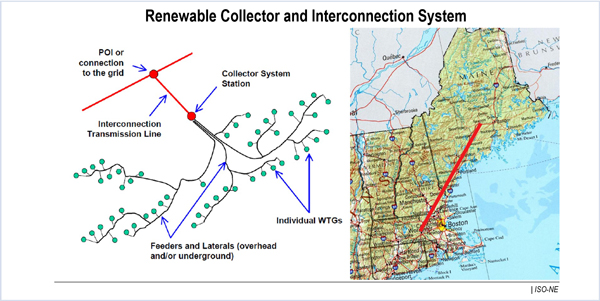ISO-NE will use the same zonal boundaries for its next two Forward Capacity Auctions.
In FCA 10 last year, ISO-NE used two zones: Rest of Pool, which comprises Connecticut, Vermont, New Hampshire, Maine, and western and central Massachusetts; and Southeastern New England (SENE), which includes Northeast Massachusetts/Greater Boston and Southeast Massachusetts/Rhode Island.
FCA 11 (2020/21) and FCA 12 (2021/21) will be conducted in four zones: Southeast Massachusetts/Rhode Island, which includes Greater Boston; Northern New England, which includes Maine, New Hampshire and Vermont; Connecticut; and Rest of Pool, generally central and western Massachusetts.
“Most major transmission projects are already certified,” Al McBride, director of transmission strategies and services, told the Planning Advisory Committee last week, meaning the RTO has determined they will be operational in time for the capacity commitment period.
As they go into service, additional portions of the Greater Hartford/Central Connecticut and Southwest Connecticut transmission project will be included in the Connecticut zone. The project is expected to be completed in 2019.
Likewise, resource retirements are unlikely to have significant impact on the zones. “Our modeling show that even if they occur, it is not likely to change the boundaries,” he said.
New Study Looks at Less Maine Wind, More Offshore
Integrating renewable resources close to load centers in the Southeast Massachusetts/Rhode Island area could be more cost effective than tapping large volumes of wind in Maine, according to a new high-level transmission cost analysis presented to PAC members last week.
In October, ISO-NE staff presented the preliminary estimates for five scenarios for integrating renewable resources in New England by 2030. (See 5 Resource Scenarios Presented to ISO-NE Planning Advisory Committee.)
Renewable energy advocacy group RENEW requested an additional analysis in which large amounts of renewable resources, primarily onshore wind in Maine as outlined in scenario 2, were changed to incorporate a more diverse mix of renewable resources spread over wider geographic areas.
Under scenario 2, Maine wind injections were assumed to be 12,872 MW in 2030, with 1,219 MW of offshore wind in Southeast Massachusetts and Rhode Island. In scenario 6, the Maine wind has been cut by more than half to 5,959 MW, with offshore wind boosted to 5,370 MW.
Even that smaller amount of Maine wind could require a complete overhaul of the AC power system, system planner Marianne Perben said.
Instead, renewable resources would be tied directly into several HVDC connectors connecting the wind integrator system to a hub in Millbury, Mass. Scenario 2 assumes a need for 9,043 MW of congestion relief, while scenario 6 envisions a need for 3,596 MW.
Splitting offshore wind resources between Connecticut, Rhode Island and Southeast Massachusetts could alleviate the need for a congestion relief system for those resources, planners said.
The analysis found that offshore wind could be imported without the need for congestion relief if it were sited off of Connecticut, Rhode Island and Southeast Massachusetts. That would allow the resources to take advantage of interconnections vacated by about 4,400 MW of resources close to the coastline that are expected to be retired by 2030: the Pilgrim nuclear plan, Millstone Unit 1, Montville Units 5 and 6, Brayton Point Units 1 through 4, and Canal Units 1 and 2.
“Under this … assumption, the cost to integrate renewable resources (excluding plant collector and interconnection system costs) in scenario 6 would be driven exclusively by the cost of integrating Maine onshore wind resources and would be significantly reduced, as compared to scenario 2,” the RTO said.
In scenario 2, the total Maine congestion relief system would cost an estimated $20 billion; in scenario 6, the price tag is estimated at $8 billion.
The estimates do not account for individual plants’ interconnection costs or potential costs from the challenge of managing large volumes of renewables during off-peak periods, the RTO said.
ISO-NE Recommends Against Keene Road Project
Staff told the PAC it is recommending the RTO not move forward on the Keene Road transmission project.
In December, staff told the committee that increasing export limits from the current 165 MW to 195 MW would save only $1.35 million to $1.38 million (2015 $) in energy production costs. (See ISO-NE Study Sees Little Savings from Keene Road Tx Upgrade.)
Written comments are due to PACmatters@iso-ne.com by Feb. 17. The RTO will report its final decision at the March or April PAC meetings.
Streamlined Regional System Plan due this Summer
ISO-NE staff is preparing a streamlined regional system plan for unveiling in the summer.
The document, which had become an unwieldy 200 pages, will come in at about 50 pages, said Michael Henderson, director of regional planning and coordination. Instead of duplicating sections of other RTO documents, links will be provided.
In response to stakeholder feedback, the plan will be produced every other year. It had formerly been produced annually.
It will include forecasts of gross load, energy efficiency and behind-the-meter photovoltaics and projections of systemwide need for capacity and reserves, along with transmission system needs.
A draft will be posted for PAC review on July 7, with comments and reviews scheduled throughout the summer. The final document will be presented at a public meeting on Sept. 14.
– William Opalka





